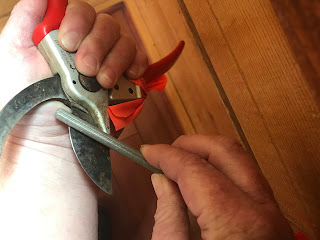It's pruning season again! And while it can feel intimidating with complicated rules for when to prune each plant and how to make various kinds of cuts, one of the easiest ways you can be successful with pruning is to make sure your tools are sharp.
Whenever you cut your plant, you are making a wound which is an opening in the plant's natural defenses. The wound creates an opportunity for diseases, fungi, bacteria and other pests to enter the plant and cause problems. The good news is you can minimize the damage from these pruning wounds.
Jagged, ragged wounds create more surface area in the nooks and crannies for pathogens to to enter the juicy, live plant tissue just under the bark. In contrast, a nice clean cut is easily compartmentalized by the plant's defense systems. When the cut surface is smooth, the plant can form a protective barrier around the wound and heal much more quickly.
 Sharp tool blades are the best way to ensure your cuts are smooth. Sharp blades slice easily through the wood, rather than tearing or smashing the tissue. Your plant will thank you!
Sharp tool blades are the best way to ensure your cuts are smooth. Sharp blades slice easily through the wood, rather than tearing or smashing the tissue. Your plant will thank you!Bypass pruners are generally recommended for most pruning tasks because they slice, rather than crush, the plant tissue, reducing the amount of damage the plant has to seal off. Bypass pruners act like a scissor, with the two blades sliding past each other.
You can clean the blades before sharpening, if you like. Alcohol is good for removing sap and steel wool can remove rust.
If you want to get more detailed information on sharpening, Oregon State Extension has an easy to follow but quite thorough guide at (insert link: http://extension.oregonstate.edu/benton/sites/default/files/sharpgdn_insights2012.pdf). It explains how to sharpen loppers, hedge trimmers, saw teeth and also how to adjust the bolts on your pruners.





Tidak ada komentar:
Posting Komentar